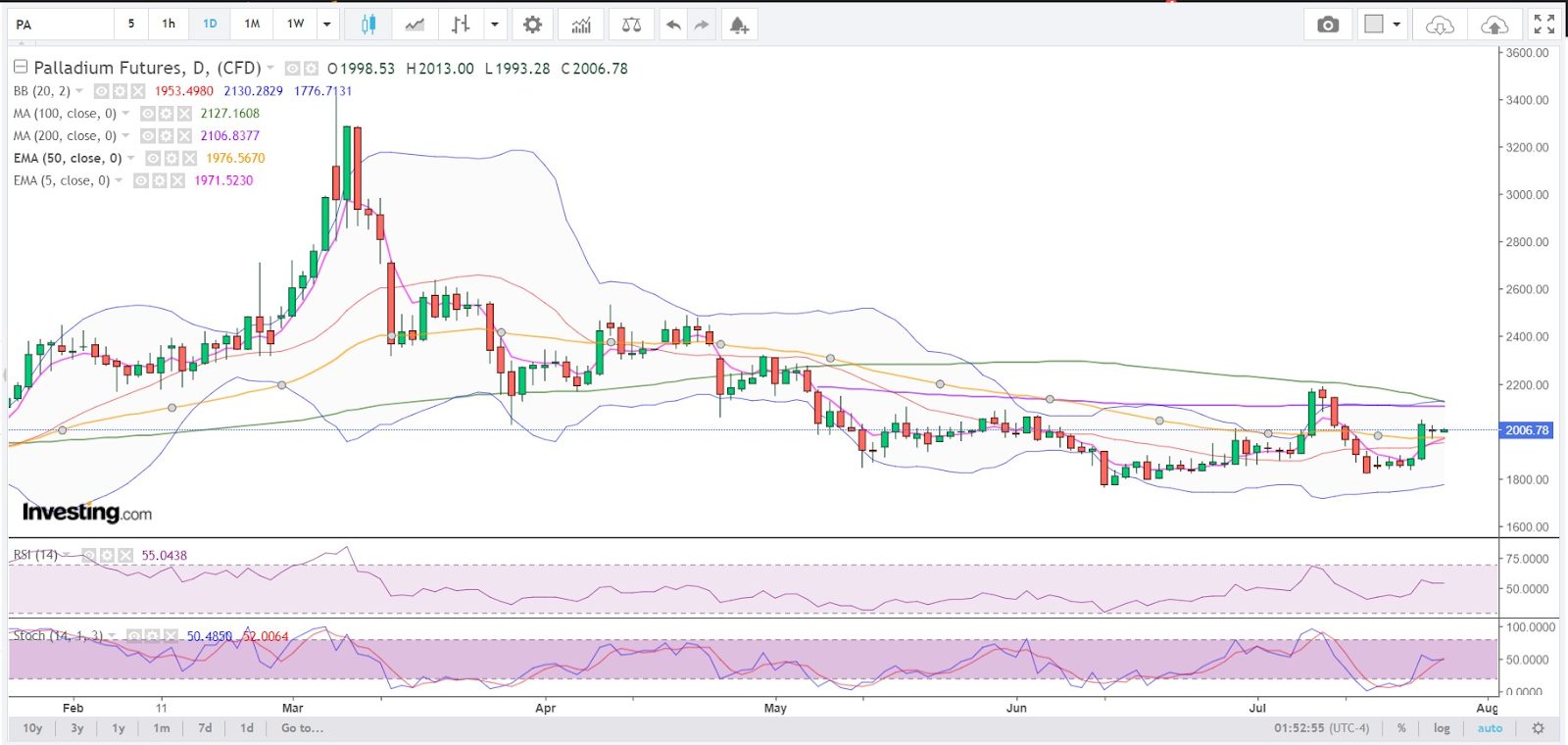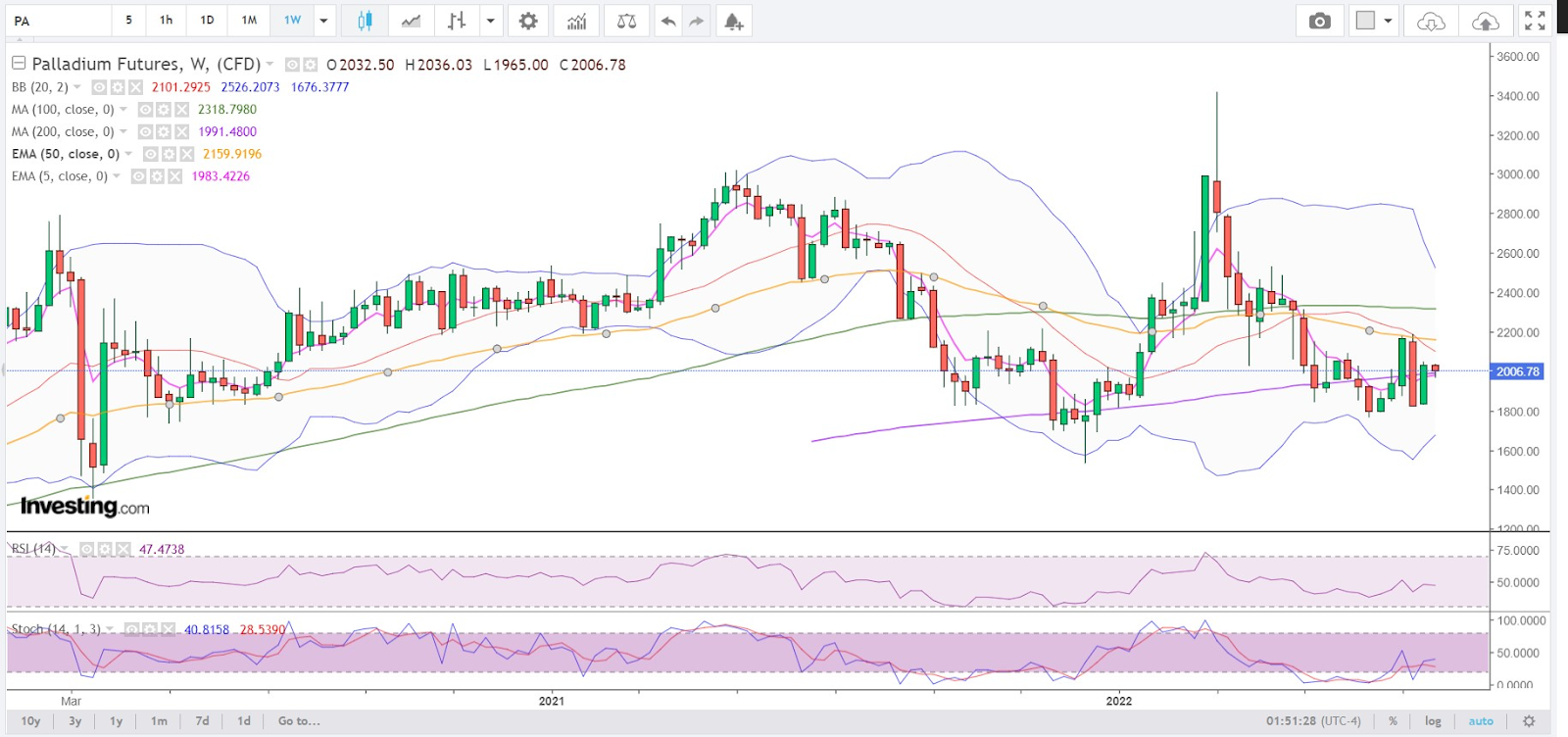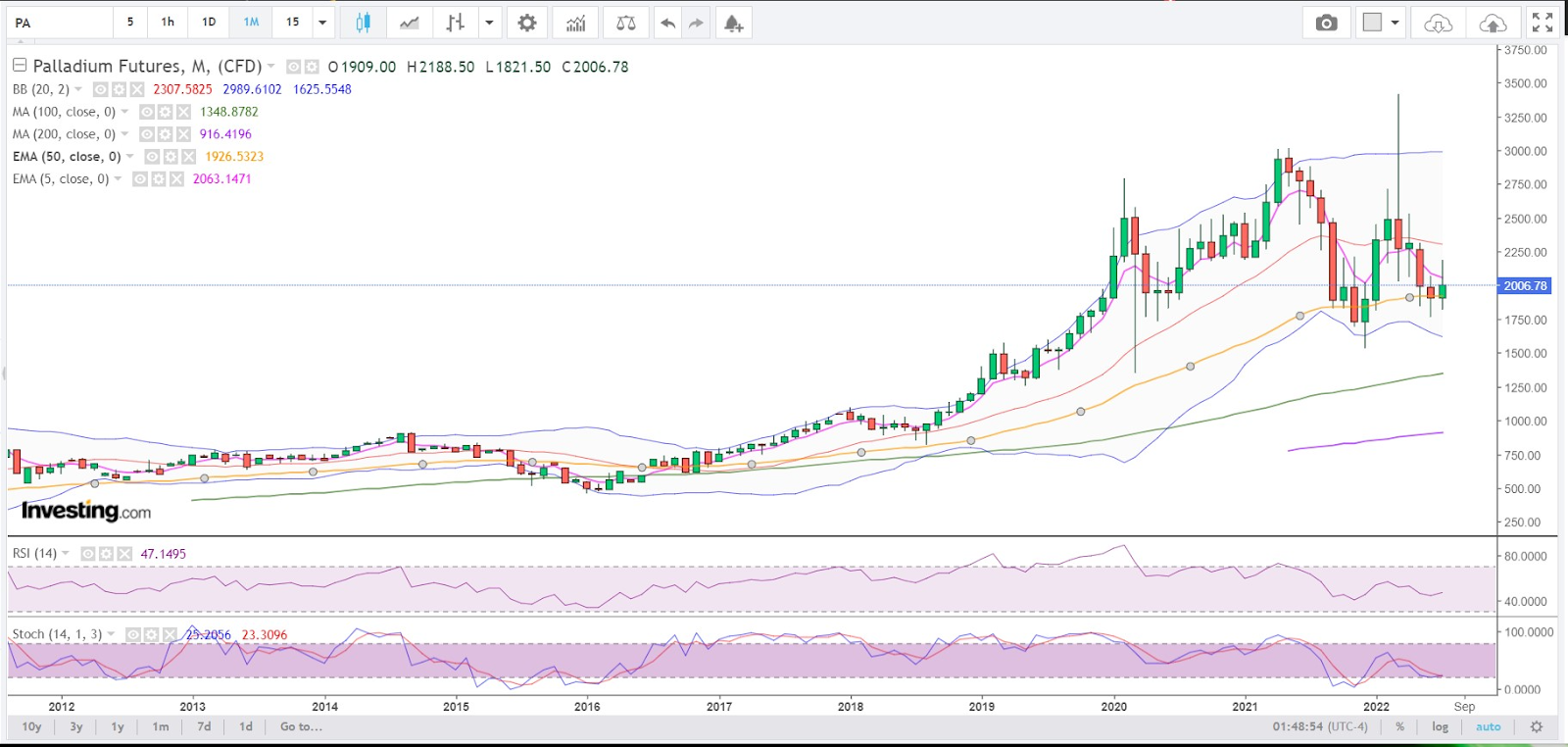- Palladium headed for first positive month in three, rising 14% from June lows
- Up 14% from June lows but still about 40% below March record highs
- Russia can squeeze palladium supply but likely won’t
Palladium prices appear to be headed for their first positive month in three, rising 14% from six-month lows beneath $1,764 an ounce hit in June.
Yet, the autocatalyst metal remains some $1,400, or 40%, below its March record high of $3,417 which was triggered by concerns about supply from major producer Russia, after the sanctions imposed on Moscow for its invasion of Ukraine.
With Russia apparently moving to weaponize its gas supplies to the West—slashing flows on the Nord Stream 1, which Germany heavily leans on, to as little as 20% of the pipeline’s capacity this week—questions are surfacing whether Moscow would act similarly with other commodities it had substantial control over, including palladium.
The odds of Russia weaponizing its palladium holdings were raised three weeks ago by Jonathan Barratt, CEO of CelsiusPro Australia, a boutique climate risk InsurTech company.
Palladium is a white metal that is rarer than gold and silver, and has considerable applications in catalytic converters, jewelry, dentistry, and electronics. The biggest demand for it is for catalytic converters in exhaust systems of particularly gasoline cars, which convert poisonous, toxic gases to harmless emissions.
Russia’s Norilsk Nickel is the world’s largest palladium producer and has slated $35 billion for upgrading infrastructure by 2030. As a nation, South Africa is the largest palladium producer.
After the March peak of $3,442, palladium prices have been volatile, with two major refiners being delisted by the London Platinum and Palladium Market in April, blocking transactions in London and New York. The market has been boxed over the past month in the $2000 range.

Charts by skcharting.com with data powered by Investing.com
Barratt, the CEO of CelsiusPro Australia, told CNBC in early July that Russia, being a major palladium producer, may choose to limit supply, raising global prices and its export revenues in a bid to counter recent G7 actions.
If Moscow wishes more “tit-for-tat” action to match the West’s restrictions on its economy, the palladium market would be a strategic target, Barrat said, adding:
“That’s probably where she will do it. Russia has some levers to play if it wants to.”
As per the Observatory of Economic Complexity (OEC), Russia accounts for approximately 25% - 26% of global palladium exports. Although its share has remained largely flat since 2016, this is in sharp contrast to South Africa, the other major producer, that has seen a consistent decline over the past 4 years.
Also as per the OEC, the largest importers of palladium in 2020 were the United Kingdom ($4.3 billion), the US ($3.8 billion), Germany ($3.5 billion), Japan ($2.5 billion), and China ($2.3 billion).
With several of these countries pushing a green agenda and the importance of the white metal in emissions control, a clampdown on palladium exports by Russia will likely be a setback to climate goals amid rising investor and public activism.
However, there’s a difference between what’s happening with gas and palladium. In the case of energy commodities from oil to gas, demand is near all-time highs with global supply barely able to keep up.
With palladium primarily serving as an emissions purifier and catalytic booster for gasoline-powered engines, demand for cars is what will matter. And here’s the problem: A global shortage of microchips—as well as steel—has slowed auto production in the most developed countries.
On one hand, this has meant fewer new cars rolling off assembly plants and into showrooms to be snapped up by buyers. On the other hand, the squeeze on automobile supply has been mitigated somewhat by fears of an oncoming recession in the US and Europe. This has prompted buyers who need a vehicle immediately to buy used cars instead, creating an inflated second-hand market.

Palladium might also see more substitution by platinum—its sister metal—which is now trading at just under $890 an ounce, or almost 60% cheaper.
Trevor Raymond, research director at the World Platinum Investment Council, said:
“We’ve argued for three years now that the price gap between the two metals means that substitution makes huge economic sense.”
Aggregate demand for palladium is expected to decline sharply in economically advanced countries, while outlooks by auto analysts show that the metal’s usage in automotive applications will likely fall in these countries.
This may cap the long-run rise in Russian export prices if palladium supply is restricted—creating an effect similar to the oil price cap intended by Washington, a move the Kremlin abhors for its potential in reducing the earnings it needs to run its economy and fund the war against Ukraine.
Russia would instead prefer to capitalize on growing demand from China and Hong Kong, which together account for nearly 18% of the global buying in palladium. Other countries that have been clients for palladium lately include North Macedonia and Brazil.
Metals Focus, an industry forecaster based in London, said due to tighter supply chains, rising costs, and more oncoming sanctions, palladium prices could reach near $2,300 levels by 2023, adding:
“The upside could be limited by a transition to higher platinum use, but this too may be challenging with ongoing disruptions, and the benefits that would accrue to Russia if platinum prices rise.”
So, where are palladium prices headed near-term?

According to Sunil Kumar, chief technical strategist at skcharting.com, the daily price action for palladium futures showed that consolidation above $1,820 helped the metal rise to $2,048 and aim for the Simple Moving Averages of the 200-Day $2,106 and the 100-Day $2,127. He added:
“A sustained break above this level can lead palladium futures higher to retest the recent swing high of $2,188.”
The rebound was also supported by the 5-Day Exponential Moving Average and middle Bollinger Band crossing over the 50-Day EMA and Daily Stochastic that maintained their positive overlap.
But Dixit also cautioned that failure to make a sustained break above $2,188 can invalidate the rebound and push prices back below $2,000 for a retest of the $1,820 support zone.
“The longer-term outlook remains sideways, with a bearish bias. Prices are likely to remain range-bound between the 100-week Simple Moving Average at the $1820-1760 support zone.”
Disclaimer: Barani Krishnan uses a range of views outside his own to bring diversity to his analysis of any market. For neutrality, he sometimes presents contrarian views and market variables. He does not hold a position in the commodities and securities he writes about.
